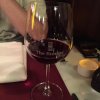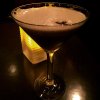Carinae Torrontes 2012 (Argentina) is a moderate yellow in colour. The nose immediately shouted ‘viognier’ at me, with dried apricots; however there’s also spiced pear, orange blossom, tropical fruits and what (to me at least) seemed like a touch of botrytis (it isn’t). The palate had good acidity and a fair dollop of residual sugar. 13% alc.
Then onto the blends. We had two whites and 8 reds, so naturally we looked at the whites first. And interesting wines they were:
Swinney Tirra Lirra Ingenue 2013 (Frankland River, WA). A blend of Riesling, Gewürztraminer and Pinot Gris. Pale yellow in colour. Lots on the nose, including apples, pear, ginger, cinnamon, lychee, lime and florals. There was also a slight touch of kero. The palate was medium acid with slight spritz and surprisingly light body. There was some candy bananas and a touch of minerality. There was discussion about ageing potential, with some likening the potential to that of Alsace Rieslings. 11.8% alc.
Between Five Bells 2013 (Geelong, Vic) was another eclectic mix. Equal parts Chardonnay, Pinot Gris, Riesling and Pinot Meunier, all co-fermented and undergoing a malolactic fermentation as well. Perhaps the meuniere component was responsible for the orange tinge in this deep yellow wine. There was a touch of sulphur initially, which blew off quickly. There’s white peach, tangerines and other tropical fruits, and one taster was adamant that he could identify ‘canned sweet corn (salt reduced)’ (and he may be right). The palate stood out for its rich texture and the slight creaminess offsetting the bracing acid. Opinion was that this would be better with food. 1655 bottles of this wine were produced.
Surprisingly, the wine of the whites was the varietal Torrontes.
The reds were presented in two brackets of four – youngest to oldest.
Scott ‘Lo Zingaro’ 2013 (Adelaide Hills) was an interesting opener. ‘Lo Zingaro’ means ‘gypsy’ and the blend of Shiraz (68%), Sangiovese (19%) and Lagrein (13%) certainly showed its multinational origins. Lifted plummy fruit, with confectionery and bubblegum juiciness. Apart from the berry characters, there was white pepper, caramel, and a touch of alcoholic heat (14% alc by the way). The palate was medium bodied, with moderate tannins and acid, enhanced by some spice, savouriness and continental meats. This was the wine of the bracket.
Woodlands Margaret 2011 (Margaret River WA) is 70% Cabernet Sauvignon, 16% Merlot and 14% Malbec. There’s a menthol note (pyrazine) over the top of the usual oak, mocha and blackcurrant characters that you would expect from a Woodlands red. The palate is medium bodied, with more mocha and juicy blackcurrant, big oak and acidity, drying tannins and a long finish. 13.5% alc
MyattsField Cabernet, Merlot, Petit Verdot 2010 (Perth Hills WA) – the ratio in the blend is 89%/9%/2%, but the Petit Verdot more than makes its mark. Rich berry fruit, with violets, chocolate, cherry and a touch of mint and leafiness. There’s the right amount of savoury oak and acid along with dusty but fine tannins, leading to a medium-long finish. 14.5% alc
To finish the bracket, we went to Portugal. Vallado (Douro) 2010 is a blend of five varieties: Tinta Barocca, Tinta Roriz (aka tempranillo), Touriga France, Touriga Nacional and Sousao. The nose was quite muted initially, but opened up to reveal savouriness, spice, leather, fennel and caraway seeds, chicory, chipotle and sumac. The palate was fresher than the nose, with dark cherry, cola, quite high acid over moderate / minimal oak, leading to quite a soft finish. In some ways, the wine is dark, inky and intense, but balanced by the softness. 13.5% alc.
A rinse of the glasses and it was on to the last four wines.
D’Arenberg ‘The Galvo Garage’ 2007 (McLaren Vale) contains Cabernet Sauvignon (48%), Merlot (25%), Petit Verdot (21%) and Cabernet Franc (6%). Lots of blackcurrant and florals, with the berry lift presumably from the Petit Verdot and Cabernet Franc. There was some leather and herbs among the lush primary fruit, and a touch of burnt match. The palate turned out to be medium bodied, with soft tannins and a medium finish – not what I was expecting after the biggish nose. Opinion was that the wine is holding, but drink up now. 14.5% alc.
Henschke Keyneton Estate Euphonium 2006 (Eden and Barossa Valleys) contains Shiraz (68%), Cabernet Sauvignon (27%), Cabernet Franc (9%) and Merlot (8%). It appeared fresher than the D’Arenberg with berry richness, but it was the palate that did it for me: smooth and totally balanced, good acid, full bodied and a long finish. Secondary development is starting to kick in, indicating hopefully a lengthy life for this wine. 14.5% alc.
The Chateau Musar 2001 (Lebanon) is a blend of Cabernet Sauvignon, Merlot and Cinsault. We gave a quiet nod to Serge Hochar (the principal, who recently passed away). The first thing that hit me was sharp VA (for which these wines are known), and then the many things going on in the glass. Leather, dried raisins, chicory, cloves, earthiness and a touch of aldehyde all hit the nostrils, while the palate showed dried red fruits, moderate oak and (surprisingly) honeycomb (think texture as well as taste). This is still evolving. 13.5% alc.
Finally, a WA wine – the Frankland Estate Olmo’s Reward 1995. This wine contains Cabernet Franc, Merlot, Cabernet Sauvignon, Malbec and Petit Verdot in descending order. I’ve had a couple of bottles of this in recent months, and this one was slightly under par. Earthiness, leather, coffee, blueberry and tobacco dominated the nose, while the palate showed drying tannins, good acidity and good structure but the fruit was diminished. Not bad for a 20 year old, but on the slide. 14% alc.

















